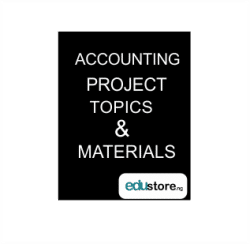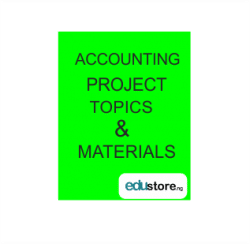FORENSIC ACCOUNTING AS A TOOL FOR FRAUD DETECTION AND PREVENTION (A STUDY OF ENUGU SOUTH LOCAL GOVERNMENT COUNCIL)
ABSTRACT
The study examines the effect of forensic accounting as a tool for fraud detection and prevention in an organization. The aim of this study is to determine the relationship between fraud detection, prevention and forensic accounting. To achieve this objective, data was collected from primary sources. The primary data were collected with the help of a well-structured questionnaire of two sections administered to staff and management of Enugu South Local Government Area. The collected data were analyzed with tables and simple percentages to analyze the research questions while Chi-square statistical tool was used to test research hypotheses. The study reveals that forensic accountant plays a significant role in an organization. The study concluded with some recommendations that forensic accounting will institute good corporate governance in the public sector which will install public confidence in the government and the entire system.
TABLE OF CONTENTS
Cover Page – – – – – – – – i
Title Page – – – – – – – – ii
Certification – – – – – – – iii
Dedication – – – – – – – – iv
Acknowledgement – – – – – – v
Abstract – – – – – – – – vii
Table of Content – – – – – – – viii
Chapter One: Introduction
- Background of the Study – – – 1
- Statement of the Problem – – – 3
- Objectives of the Study – – – – 4
- Research Questions – – – – – 5
- Research Hypothesis – – – – – 5
- Significance of the Study – – – – 6
- Scope of the Study – – – – – 7
- Limitation of the Study – – – – 7
- Definition of Terms and Acronyms – – 8
Chapter Two: Review of Related Literature
2.1 Introduction – – – – – – 10
2.2 Concept of Forensic Accounting – – – 12
2.3 Forensic Accountants and Auditors – – 14
2.4 History of Forensic Accounting – – – 15
2.5 Forensic Accounting practice, fraud and corruption
from global and Nigerian perspectives – – 16
2.6 Forensic Accounting Education – – 19
2.7 Forensic Accounting and fraud detection – 20
2.8 The Role and skills of Forensic Accounting- – 24
2.9 Theoretical framework – – – – – 30
Chapter Three: Research Methodology and Procedure
3.1 Introduction – – – – – – 34
3.2 Research Design – – – – – – 34
3.3 Area of the Study – – – – – 35
3.4 Population of the Study – – – – 35
3.5 Sample Size and Sampling Techniques – – 35
3.6 Sources of Data – – – – – – 36
3.7 Method of Data Collection – – – 36
3.8 Method of Data Analysis – – – – 37
Chapter Four: Presentation, Analysis and Interpretation of Data
4.1 Introduction – – – – – – 38
4.2 Presentation and Analysis of Data – – – 38
4.3 Testing of Hypotheses – – – – – 43
4.4 Discussion of Findings – – – – 47
Chapter Five: Summary, Conclusion
and Recommendations
5.1 Introduction – – – – – – 49
5.2 Summary – – – – – – – 49
5.3 Conclusion – – – – – – – 50
5.4 Recommendations – – – – – 52
References – – – – – – – 54
Appendices – – – – – – 58
DOWNLOAD COMPLETE WORK- For Reference Only: Materials are for research, citation, and idea generation purposes and not for submission as your original final year project work.
- Avoid Plagiarism: Do not copy or submit this content as your own project. Doing so may result in academic consequences.
- Use as a Framework: This complete project research material should guide the development of your own final year project work.
- Academic Access: This platform is designed to reduce the stress of visiting school libraries by providing easy access to research materials.
- Institutional Support: Tertiary institutions encourage the review of previous academic works such as journals and theses.
- Open Education: The site is maintained through paid subscriptions to continue offering open access educational resources.






